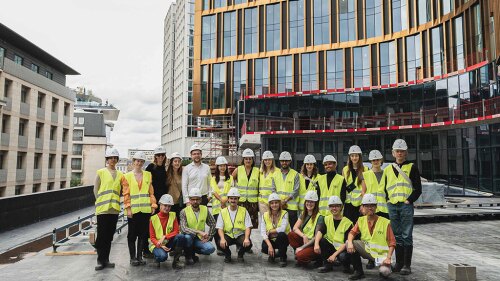Contributing around 37 percent of energy related carbon emissions, the built environment has a clear responsibility to urgently decarbonize real estate to meet international climate targets and mitigate climate change risks. However, with estimates suggesting that up to US$24.2 trillion—or nearly 17% of global financial assets—could be at risk due to climate-related financial shocks under high-emissions scenarios, the real estate sector in particular must act swiftly.
In Europe alone, approximately €1.5 trillion worth of property is at risk of devaluation without deep retrofitting to meet tightening energy and carbon standards, underscoring the urgent need for scalable, sector-wide solutions to accelerate decarbonization and preserve asset value.
To address this, a new report from the Urban Land Institute (ULI), supported by C Change and Net Zero Imperative, outlines the key barriers to decarbonization, and presents seven guiding principles that address asset stranding risk. These universally applicable principles are based on the findings of leading, multidisciplinary experts who participated in a recent Advisory Services Panel (ASP) conducted in Berlin, which provides objective advice on land use and urban development challenges, and delivers strategic recommendations informed by sustainability, resilience and community well-being.
This panel focused on two place-based case studies with a higher stranding risk: Buckower Höfe, a large-scale affordable housing estate in Berlin’s Neukölln district facing significant energy inefficiencies and socioeconomic issues, and the Kurfürstendamm commercial district in west Berlin, which faces increasing vacancy rates and declining asset values,
Failure to decarbonize buildings risks economic asset stranding, with older, inefficient building stock at higher risk. Risk factors include the cost-and-viability impacts of regulations concerning minimum energy performance standards, and disclosure rules; shifts in investor and occupier demand for sustainable buildings; physical climate risk from extreme weather and rising temperatures; and structural market trends such as demographic shifts and remote working increasing the risk of obsolescence.
Assets facing disproportionately higher risk of stranding are those low revenue assets with limited revenue growth potential or major physical and social constraints, such as aging social and affordable housing, where the business case for the owner to retrofit or regenerate and recoup costs is weakened. Often the costs come down to the owner, while benefits are more diffused among different stakeholders, including occupiers through lower energy bills, the government through higher taxes and the wider society through societal and environmental benefits and cost savings.
This approach requires a differentiated mindset from costs to investment and a holistic approach integrating decarbonization into a wider urban regeneration perspective. Potential solutions include densification of urban projects and adding additional uses, innovative financing tools and governance models that avoid social costs, stronger public sector leadership and facilitation, health improvements and community resilience, to ensure equitable and financially viable climate transition efforts across all asset classes.
Lisette van Doorn, CEO of ULI Europe, said: “The decarbonization of real estate is not solely an urgent climate imperative, it can become a social one too. This provides the potential for decarbonization be a catalyst for very real social and economic revitalization. However, this requires a totally different mindset from all stakeholders involved. It starts with changing the mindset from a cost to investment perspective, followed by identifying who benefits from these investments, who should pay and based on these two elements, decide who is then best placed to lead.”
“When assessing benefits, a holistic approach is required, not just taking into account monetary aspects such as rent and value uplifts, but also qualitative aspects such as potential future social and health costs savings resulting from more vibrant, safer and healthy neighborhoods, However, this requires trust and collaboration between all the different stakeholders and a long term perspective, especially between public and private sector. The findings of the Berlin Advisory Services Panel present a very useful guide for how impacted projects or neighbourhoods might be transformed everywhere, to the benefit of all stakeholders.”
In brief, the seven guiding principles proposed by the report include:
- Mindset shift: cost to investment approach: an approach to decarbonization that shifts from a pure cost focus to an investment focus that generates a return on that investment, either quantitative or qualitative, such as long term environmental, social and economic returns. It incorporates a blended finance approach of both public and private funding and institutional capital, that distributes risk, aligns interests, and mobilizes investors.
- Clarify who benefits, who pays, and who leads: an integrated governance lens is needed to decarbonize urban districts, especially with high stranding risk assets, to distinguish between who leads, pays, and benefits from these interventions. The disconnect between value creation and investment capacity should be addressed through governance structures that align responsibilities with benefits. This is key to ensuring a just transition that shares costs fairly and scales neighborhood transformation efforts efficiently.
- The integrated, place-based vision: decarbonization isn’t solely about reducing emissions; a place-based approach provides the potential to revitalize entire districts into thriving, sustainable and resilient communities, leveraging environmental, social and economic benefits through an integrated systems approach that transcends compliance obligations into a catalyst for change.
- Governance & Collective Ownership: decarbonization at the neighborhood scale needs governance structures that align interests, release investment, and embed long-term accountability, by coordinating all stakeholders around a shared climate and regeneration strategy.
- Building the business case for successful urban development: this principle focuses on opportunities to: generate higher land values and economic productivity via higher densities; mix uses to enhance economic productivity and cross-subsidize, e.g. through value-capture mechanisms, higher value development opportunities with social and transport infrastructure and climate resilience, improving livability and vibrancy.
- Cyclical Value Creation: strategies for densification, mixed use, and investment in sustainable infrastructure may create cyclical value, but this requires a coherent placemaking vision that coordinates public and private investment, enabled by equitable mechanisms to distribute cost and benefits. A robust business case built on cyclical value creation can drive economic and decarbonization transition at scale.
- Systems thinking across scales: Achieving these principles requires a systems-level approach to decarbonization that holistically integrates strategies across scales—across building, neighborhood and city.
The ULI Advisory Services Panel report illustrates all these guiding principles for decarbonization, applied to the two case studies in Berlin.
Download the full report, Berlin - Turning Risk into Opportunity: Decarbonizing Stranded Assets at a Neighborhood Scale, from ULI Knowledge Finder.





